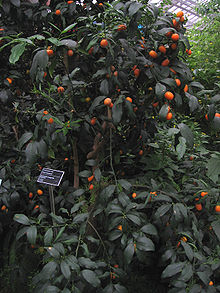- Citrus japonica 'Japonica'
-
Citrus japonica 'Japonica' 
Scientific classification Kingdom: Plantae (unranked): Angiosperms (unranked): Eudicots (unranked): Rosids Order: Sapindales Family: Rutaceae Genus: Citrus Species: C. japonica 'Japonica' Binomial name Citrus japonica 'Japonica' Citrus japonica 'Japonica' (common name: Marumi Kumquat or Morgani Kumquat) is a species of Kumquat. It is an evergreen tree. It produces edible golden-yellow colored fruit. The fruit is small and usually round but can be oval shaped. The peel has a sweet flavor but the fruit has a sour center. The fruit can be eaten raw and but mainly used to make marmalade and jelly. It is grown as an ornamental plant and can be used in bonsai. This plant is symbolized as good luck and are presented during the Chinese new year. It's more commonly cultivated than most other kumquats as it is cold tolerant. It can be kept as a houseplant.
Carl Peter Thunberg originally classified the kumquats as members of the citrus genus in 1784 in his book Flora Japonica. They were moved to a new genus, Fortunella, in 1915 by Walter T. Swingle in honor of Robert Fortune. In accordance with the 1994 Tokyo Code of the International Code of Botanical Nomenclature, the genus name reverted to Citrus.[1][2][3]
Notes
- ^ International Code of Botanical Nomenclature (Tokyo Code) 1994 Ch. II, Sec. III Article 11.3 "For any taxon from family to genus inclusive, the correct name is the earliest legitimate one with the same rank"
- ^ Nicolosi et al. (Theor. Appl. Genetics 100: 1155–1166. 2000)
- ^ Mabberley (Blumea 49: 481–498. 2004)
External links
Categories:- Citrus
- Flora of China
- Fruits originating in Asia
- Garden plants of Asia
- House plants
- Ornamental trees
- Rutaceae stubs
- Fruit stubs
Wikimedia Foundation. 2010.
